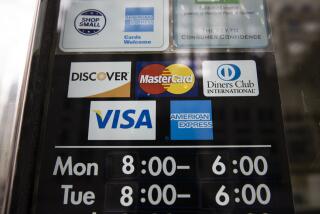Credit Card Use and Debt Rise in India
- Share via
NEW DELHI, India — A year ago, Arun Kumar couldn’t afford the color television and stereo his two teenage daughters were pestering him for.
He still can’t afford them. But today, with a new credit card in hand, Kumar has them--and is building debt.
Credit reflects a paramount change in India’s society. Until recently, India was a country of the very rich and the very poor. Today, a burgeoning middle class is fueling a new consumer drive.
And as more Indians covet the latest fashions and household goods, a buy-now, pay-later culture is replacing cautious habits that once saw most Indians hoard their savings in gold and jewelry.
Consumers, shop owners and banks are struggling to keep pace with changes brought about by the increasing use of plastic money since the government began opening up the economy in 1991.
“I decided to go in for a credit card because there was no down payment needed on purchases,” said Kumar, an insurance company executive. “I have incurred a debt of 18,000 rupees [$515] in less than a year--twice my monthly salary--but I will be able to service the loan.”
The 2.5% monthly interest, totaling about 450 rupees [$13], is just within his budget.
It’s unclear how much of the new middle-class purchasing power is based on liquid assets and how much on credit.
In India’s capital, New Delhi, a recent newspaper poll found that 32% of the middle-class people surveyed had credit cards. Of those, 57% said they overspent because of the cards.
Credit cards are changing the way many Indians spend money, and more people are likely to follow suit.
“The card market in India is one of the fastest growing in the Asia-Pacific region, with an average annual growth rate of 50%,” said Chandra Agnihotri, manager of Visa International’s India operation.
Shop owners also have been forced to rethink their sales options. Some businesses say 15% to 20% of their daily sales are now on credit. Less than a decade ago, few but the top tourist-oriented stores honored any cards.
“In the 1980s, banks would take up to a month to pay them money for the goods sold on their credit cards. Now we can get it within 24 hours,” said Mahesh Lakhani, managing director of Novelty Radios and Watch Experts Co.
The business of selling credit is still a nascent industry in India, where only about 2 million out of a population of 920 million have credit cards.
Once consumer financing filters down to small cities and towns, the credit card business will flourish, D.V. Mohindra, a Bank of India manager, said.
MasterCard International hopes to issue 2 million rupee-based cards by the end of 1997.
Increased card usage, however, comes at the price of more bad debt.
About 5% of all card users in India have become delinquent on their payments, Mohindra said.
Collection and debt recovery is a growth industry. Half a dozen private debt-recovery firms have sprung up in the Indian capital since 1991, employing mainly retired soldiers to collect old debts.
Many defaulters see their cars snapped up by a new breed of “repo men,” hefty debt collectors who show up at their homes at odd hours.
More to Read
Inside the business of entertainment
The Wide Shot brings you news, analysis and insights on everything from streaming wars to production — and what it all means for the future.
You may occasionally receive promotional content from the Los Angeles Times.










